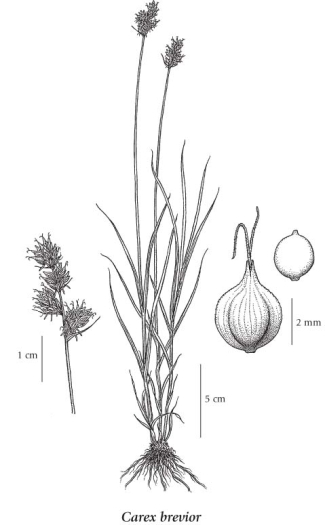Carex brevior (Dewey) Mack.
short-beaked sedge (shortbeak sedge)
Cyperaceae (Sedge family)
Introduction to Vascular Plants
short-beaked sedge (shortbeak sedge)
Cyperaceae (Sedge family)
Introduction to Vascular Plants
Photograph
© Thayne Tuason (Photo ID #76896)
Species Information
General:
Perennial, tufted herb from fibrous roots; stems 20-80 cm tall, exceeding the leaves.
Leaves:
Sheaths tight; blades flat or folded, 2-4 mm wide, borne on the lower 1/3 of the stem.
Flowers:
Spikes 3 to 6, aggregated into a 1- to 5-cm long, often interrupted head, unstalked, with both female and male flowers, the female ones towards the tips; bracts subtending the spikes sheathless, reduced, inconspicuous.
Fruits:
Perigynia broadly egg-shaped to nearly globe-shaped, 3.2-4.6 mm long, 2.2-3.5 mm wide, pale green to tan, more or less flattened, the margins winged nearly to the bases and the upper 1/2 fringed with teeth, with nerves on both sides or nerveless below, the beaks shallowly bidentate, less than 1 mm long, narrowly margined and toothed below; female scales elliptical, brownish with translucent margins, somewhat shorter and narrower than the perigynia; stigmas 2; achenes lens-shaped, 1.7-2 mm long. vol6_2
Illustration

If more than one illustration is available for a species (e.g., separate illustrations were provided for two subspecies) then links to the separate images will be provided below. Note that individual subspecies or varietal illustrations are not always available.
Illustration Source: The Illustrated Flora of British Columbia
Ecology
Ecological Framework for Carex brevior
The table below shows the species-specific information calculated from
original data (BEC database) provided by the BC Ministry of Forests and Range.
(Updated August, 2013)
The table below shows the species-specific information calculated from
original data (BEC database) provided by the BC Ministry of Forests and Range.
(Updated August, 2013)
| Site Information |
Value / Class |
||
|
Avg |
Min |
Max |
|
| Elevation
(metres) |
1645 | 1318 | 1842 |
| Slope
Gradient (%) |
55 | 32 | 85 |
|
Aspect (degrees) |
205 | 178 | 260 |
| Soil
Moisture Regime (SMR) [0 - very xeric; 4 - mesic; 8 - hydric] |
3 | 2 | 4 |
| Modal
Nutrient Regime
Class |
C | ||
| #
of field plots species was recorded in: |
3 | ||
| Modal
BEC Zone Class |
ESSF | ||
|
All BEC Zones (# of stations/zone) species was recorded in |
ESSF(3) | ||
|
Source:
Klinkenberg 2013
|
|||
Habitat and Range
Moist to mesic meadows, forest margins, and streambanks in the steppe and montane zones; infrequent in SC and SE BC; E to PQ, NB and NS and S to ME, MA, VA, TN, MS, TX, NM, AZ, ID and OR.Status Information
Synonyms
Synonyms and Alternate Names:
Carex festucacea var. brevior (Dewey) Fernald